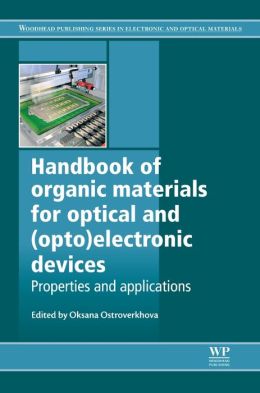 [内容简介]
[内容简介]
Small molecules and conjugated polymers, the two main types of organic materials used for optoelectronic and photonic devices, can be used in a number of applications including organic light-emitting diodes, photovoltaic devices, photorefractive devices and waveguides. Organic materials are attractive due to their low cost, the possibility of their deposition from solution onto large-area substrates, and the ability to tailor their properties. The Handbook of organic materials for optical and (opto)electronic devices provides an overview of the properties of organic optoelectronic and nonlinear optical materials, and explains how these materials can be used across a range of applications.
Parts one and two explore the materials used for organic optoelectronics and nonlinear optics, their properties, and methods of their characterization illustrated by physical studies. Part three moves on to discuss the applications of optoelectronic and nonlinear optical organic materials in devices and includes chapters on organic solar cells, electronic memory devices, and electronic chemical sensors, electro-optic devices.
The Handbook of organic materials for optical and (opto)electronic devices is a technical resource for physicists, chemists, electrical engineers and materials scientists involved in research and development of organic semiconductor and nonlinear optical materials and devices.
- Comprehensively examines the properties of organic optoelectric and nonlinear optical materials
- Discusses their applications in different devices including solar cells, LED's and eletronic memory devices
- An essential technical resource for physicists, chemists, electrical engineers and materials scientists
[目录]
Part 1 Materials for organic (opto)electronics and nonlinear optics structure-property relations: Small molecular weight materials for (opto)electronics applications: Overview; Influence of film morphology on optical and electronic properties of organic materials; Doping effects on charge transport in organic materials; Third-order nonlinear optical properties of Pi-conjugated polymers constituted of thiophene units and molecular assembly of the polymers; Small molecule supramolecular assemblies for third order nonlinear optics; Molecular crystals and crystalline thin films for photonics
Part 2 (Opto)electronic and nonlinear optical properties of organic materials and their characterization: Charge generation and transport in organic materials; Optical, photoluminescent, and electroluminescent properties of organic materials; Nonlinear optical properties of organic materials; Ultrafast intrachain exciton dynamics in Pi-conjugated polymers; Ultrafast charge carrier dynamics in organic (opto)electronic materials; Short-pulse induced photocurrent and photoluminescence in organic materials; Conductivity measurements of organic materials using field-effect transistors (FETs) and space-charge-limited current (SCLC) technique; Charge transport features in disordered organic materials measured by time-of-flight (TOF), xerographic discharge (XTOF) and charge extraction by linearly increasing voltage (CELIV) techniques; Surface-enhanced Raman scattering (SERS) characterization of metal-organic interactions; Second harmonic generation as a characterization technique and phenomological probe for organic materials
Part 3 Applications of (opto)electronic and nonlinear optical organic materials in devices: Organic solar cells; Organic light-emitting diodes; Organic spintronics; Organic semiconductors for electronic chemical sensors; Organic bioelectronics; Organic electronic memory devices; Unconventional molecular scale logic devices; Photorefractive (PR) polymers and their recent applications; Organic waveguides, ultra-low loss demultiplexers and electro-optic (EO) polymer devices

 新书报道
新书报道